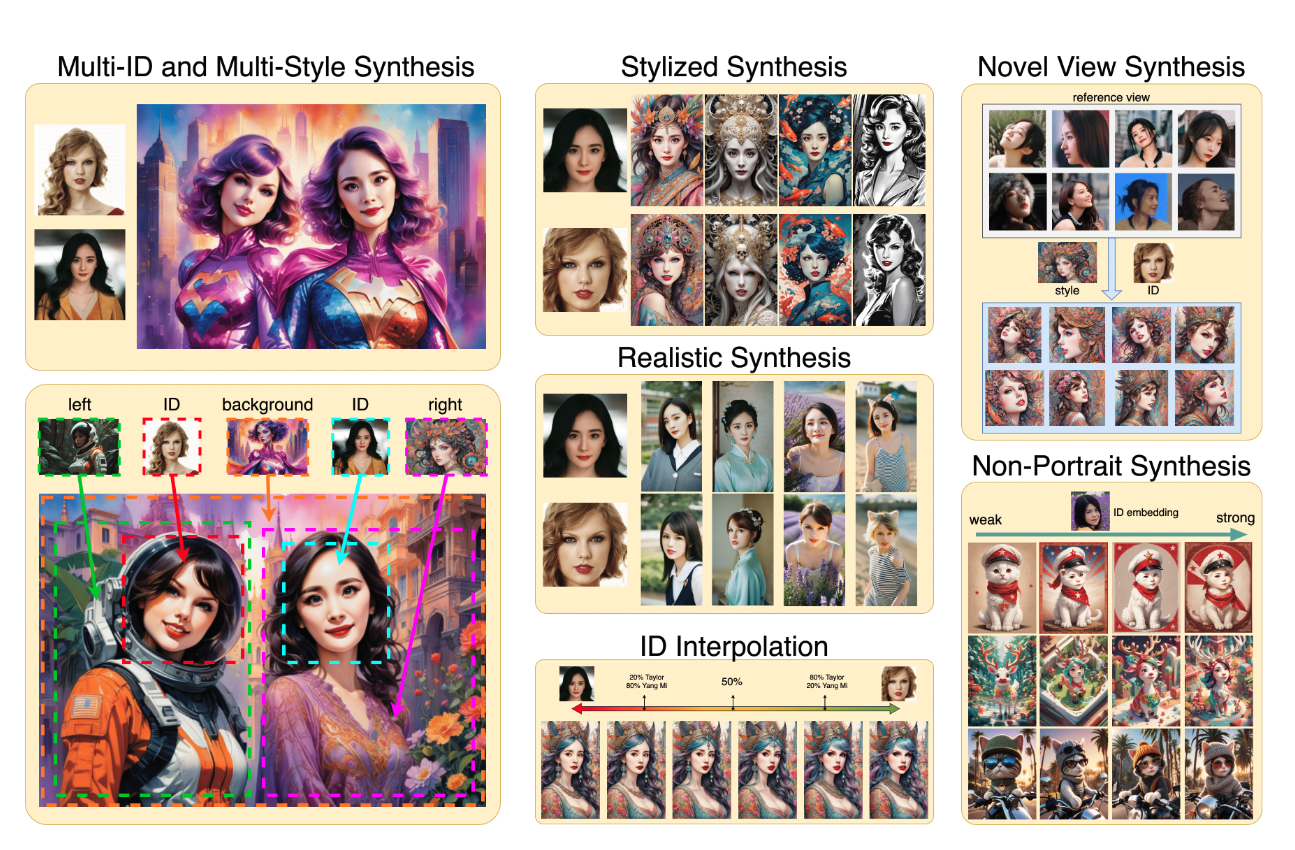instant-id-albedobase-xl
Maintainer: tgohblio

41

| Property | Value |
|---|---|
| Model Link | View on Replicate |
| API Spec | View on Replicate |
| Github Link | View on Github |
| Paper Link | View on Arxiv |
Create account to get full access
Model overview
instant-id-albedobase-xl is a state-of-the-art AI model for zero-shot identity-preserving generation. Developed by the InstantX Team at Xiaohongshu Inc., it uses the AlbedoBase-XL v2.0 as its base model and incorporates proprietary techniques like LCM-LoRA acceleration and multi-ControlNets to achieve fast, high-quality results.
This model is similar to other InstantID variants like instant-id-multicontrolnet, instant-id-photorealistic, and instant-id-artistic. It also shares some similarities with the latent-consistency-model in terms of speed and control.
Model inputs and outputs
instant-id-albedobase-xl takes in an input image, prompt, and various settings to control the generation process. It outputs a new image that preserves the identity of the input face while stylizing it based on the given prompt.
Inputs
- Image: The input face image to use as a reference for identity preservation.
- Prompt: The text prompt describing the desired style and attributes for the generated image.
- Negative Prompt: The text prompt describing what should be avoided in the generated image.
- Width/Height: The desired dimensions of the output image.
- Guidance Scale: The scale for classifier-free guidance, with an optimum range of 0-5 when using LCM-LoRA.
- Safety Checker: A flag to enable or disable the built-in safety checker.
- IP Adapter Scale: The scale for the Identity Preserving Adapter, which controls the balance between identity preservation and style.
- Num Inference Steps: The number of denoising steps, with an optimum range of 6-8 when using LCM-LoRA.
- Controlnet Conditioning Scale: The scale for the ControlNet conditioning, which affects the balance between the input face and the generated style.
Outputs
- Output Image: The generated image that preserves the identity of the input face while matching the desired style and attributes.
Capabilities
instant-id-albedobase-xl is capable of generating high-quality, identity-preserving images in a matter of seconds. It can handle a wide range of styles and attributes, from photorealistic to artistic. The model's ability to balance identity preservation and style integration sets it apart from previous state-of-the-art techniques.
What can I use it for?
This model can be useful for various applications, such as:
- Portrait Generation: Create stylized portraits of real people for use in art, design, or entertainment projects.
- Character Design: Generate custom character designs with a consistent identity, but diverse styles.
- Content Creation: Quickly produce visually striking images for blogs, social media, or other online content.
- Personalized Marketing: Create unique, identity-based visuals for personalized advertising or branding campaigns.
Things to try
One key advantage of instant-id-albedobase-xl is its compatibility with LCM-LoRA, which allows for significantly faster inference times without sacrificing quality. By adjusting the guidance scale and number of inference steps, you can find the sweet spot between speed and fidelity for your specific use case.
Additionally, experiment with different base models and ControlNet configurations to achieve unique styles and better integration between the face and background. The maintainer's Hugging Face profile can be a useful resource for exploring these options.
This summary was produced with help from an AI and may contain inaccuracies - check out the links to read the original source documents!
Related Models

sdxl-lightning-4step

158.8K
sdxl-lightning-4step is a fast text-to-image model developed by ByteDance that can generate high-quality images in just 4 steps. It is similar to other fast diffusion models like AnimateDiff-Lightning and Instant-ID MultiControlNet, which also aim to speed up the image generation process. Unlike the original Stable Diffusion model, these fast models sacrifice some flexibility and control to achieve faster generation times. Model inputs and outputs The sdxl-lightning-4step model takes in a text prompt and various parameters to control the output image, such as the width, height, number of images, and guidance scale. The model can output up to 4 images at a time, with a recommended image size of 1024x1024 or 1280x1280 pixels. Inputs Prompt**: The text prompt describing the desired image Negative prompt**: A prompt that describes what the model should not generate Width**: The width of the output image Height**: The height of the output image Num outputs**: The number of images to generate (up to 4) Scheduler**: The algorithm used to sample the latent space Guidance scale**: The scale for classifier-free guidance, which controls the trade-off between fidelity to the prompt and sample diversity Num inference steps**: The number of denoising steps, with 4 recommended for best results Seed**: A random seed to control the output image Outputs Image(s)**: One or more images generated based on the input prompt and parameters Capabilities The sdxl-lightning-4step model is capable of generating a wide variety of images based on text prompts, from realistic scenes to imaginative and creative compositions. The model's 4-step generation process allows it to produce high-quality results quickly, making it suitable for applications that require fast image generation. What can I use it for? The sdxl-lightning-4step model could be useful for applications that need to generate images in real-time, such as video game asset generation, interactive storytelling, or augmented reality experiences. Businesses could also use the model to quickly generate product visualization, marketing imagery, or custom artwork based on client prompts. Creatives may find the model helpful for ideation, concept development, or rapid prototyping. Things to try One interesting thing to try with the sdxl-lightning-4step model is to experiment with the guidance scale parameter. By adjusting the guidance scale, you can control the balance between fidelity to the prompt and diversity of the output. Lower guidance scales may result in more unexpected and imaginative images, while higher scales will produce outputs that are closer to the specified prompt.
Updated Invalid Date

instant-id-multicontrolnet

126
The instant-id-multicontrolnet model is an extension of the popular InstantID model, developed by the Replicate creator tgohblio. This model leverages the power of ControlNets to provide advanced image generation capabilities, allowing users to create realistic images of people with customizable features and settings. The model builds upon the foundation of the InstantID model, which is known for its ability to generate highly realistic images of real people. The instant-id-multicontrolnet model adds additional capabilities, such as the ability to control various aspects of the generated image through the use of ControlNets. This includes features like pose, canny edges, depth maps, and more. Model inputs and outputs The instant-id-multicontrolnet model accepts a variety of inputs, including an image of a face, a reference pose image, and a text prompt. The model then generates a new image based on these inputs, adhering to the specified parameters and settings. Inputs face_image_path: The path to an input image of a face pose_image_path: The path to a reference pose image prompt: The text prompt describing the desired image negative_prompt: The text prompt describing the aspects to be avoided in the generated image model: The SDXL image model to be used enable_fast_mode: A toggle to enable or disable SDXL-Lightning fast inference lightning_steps: The number of denoising steps to use for SDXL-Lightning scheduler: The scheduler algorithm to be used width: The width of the output image height: The height of the output image adapter_strength_ratio: The scale for the IP adapter identitynet_strength_ratio: The scale for the ControlNet conditioning pose: A toggle to enable or disable the use of the ControlNet pose model pose_strength: The scale for pose conditioning canny: A toggle to enable or disable the use of the ControlNet canny edge model canny_strength: The scale for canny edge conditioning depth_map: A toggle to enable or disable the use of the ControlNet depth model depth_strength: The scale for depth map conditioning num_steps: The number of denoising steps guidance_scale: The scale for classifier-free guidance seed: The RNG seed number safety_checker: A toggle to enable or disable the NSFW filter Outputs The generated image, represented as a URI. Capabilities The instant-id-multicontrolnet model is capable of generating highly realistic images of people, with the added ability to control various aspects of the image through the use of ControlNets. This allows users to create images that closely match their desired specifications, such as a specific pose, facial features, or environmental context. What can I use it for? The instant-id-multicontrolnet model can be used for a variety of applications, such as: Content creation**: Generating realistic images of people for use in various media, such as social media, advertising, or film/TV productions. Character design**: Creating custom character designs for use in video games, animations, or other creative projects. Virtual photography**: Capturing unique and compelling images of virtual subjects for artistic or commercial purposes. Personalization**: Generating personalized images based on user preferences and inputs, such as profile pictures or avatars. Things to try One interesting aspect of the instant-id-multicontrolnet model is its ability to blend multiple ControlNet modalities, such as pose, canny edges, and depth maps, to create more complex and nuanced images. By experimenting with different combinations of these inputs, users can discover unique and unexpected visual outcomes. Another interesting feature is the model's "fast mode" option, which enables SDXL-Lightning for faster inference times. This can be useful for rapid prototyping or real-time applications, although it may come at the cost of some image quality. Comparing the results of the fast mode to the standard mode can provide insights into the trade-offs between speed and fidelity.
Updated Invalid Date

instant-id-photorealistic

23
instant-id-photorealistic is a state-of-the-art AI model developed by grandlineai that can generate photorealistic images of individuals in a matter of seconds. This model builds upon the powerful Juggernaut-XL v8 base model and aims to preserve the identity and characteristics of the input face while allowing for flexible control over the generated image's style and composition. The instant-id-photorealistic model is closely related to other advanced face generation and editing models like instant-id, gfpgan, juggernaut-xl-v9, instant-id-multicontrolnet, and real-esrgan. These models offer a range of capabilities, from face restoration and enhancement to highly customizable image generation. Model inputs and outputs The instant-id-photorealistic model takes in a single input image and a text prompt, and generates a photorealistic image that preserves the identity of the input face while allowing for flexible control over the style and composition of the output image. Inputs Image**: The input image containing the face to be used as the reference for identity preservation. Prompt**: The text prompt that describes the desired style, composition, and other attributes of the generated image. Negative Prompt**: An optional text prompt that specifies undesired attributes to be avoided in the generated image. Width/Height**: The desired width and height of the output image. Guidance Scale**: The scale factor for the classifier-free guidance, which controls the influence of the text prompt on the generated image. IP Adapter Scale**: The scale factor for the IP adapter, which controls the influence of the input face on the generated image. Controlnet Conditioning Scale**: The scale factor for the ControlNet conditioning, which controls the influence of the input face's pose and features on the generated image. Num Inference Steps**: The number of denoising steps used during the image generation process. Outputs Generated Image**: The photorealistic image that preserves the identity of the input face while reflecting the desired style and composition specified in the text prompt. Capabilities The instant-id-photorealistic model excels at generating photorealistic images that maintain the identity of the input face, while allowing for a high degree of control over the final style and composition of the output. This makes it a powerful tool for a variety of applications, such as portrait editing, character design, and creative image generation. What can I use it for? The instant-id-photorealistic model can be used for a wide range of applications, including: Portrait Editing**: Easily create photorealistic portraits of individuals with customizable styles and compositions, without the need for extensive editing or retouching. Character Design**: Generate highly detailed and photorealistic character designs for use in various creative projects, such as films, games, or illustrations. Creative Image Generation**: Explore and experiment with different artistic styles and compositions while preserving the identity of the input face, opening up new possibilities for creative expression. Things to try One interesting aspect of the instant-id-photorealistic model is its ability to seamlessly blend the input face with the desired style and composition specified in the text prompt. This allows for the creation of unique and visually striking images that maintain a strong sense of realism, while incorporating elements of fantasy, surrealism, or other artistic styles. For example, you could try generating a portrait of a character in a film noir style, with dramatic lighting, moody shadows, and a sense of mystery. Alternatively, you could experiment with blending the input face with more abstract or experimental art styles, such as cubism or expressionism, to create truly one-of-a-kind artworks. The model's versatility and high degree of control also make it a valuable tool for tasks like character design, where you can quickly generate a range of photorealistic character concepts with varying styles and attributes, all while preserving the core identity of the input face.
Updated Invalid Date

instant-id

485
instant-id is a state-of-the-art AI model developed by the InstantX team that can generate realistic images of real people instantly. It utilizes a tuning-free approach to achieve identity-preserving generation with only a single input image. The model is capable of various downstream tasks such as stylized synthesis, where it can blend the facial features and style of the input image. Compared to similar models like AbsoluteReality V1.8.1, Reliberate v3, Stable Diffusion, Photomaker, and Photomaker Style, instant-id achieves better fidelity and retains good text editability, allowing the generated faces and styles to blend more seamlessly. Model inputs and outputs instant-id takes a single input image of a face and a text prompt, and generates one or more realistic images that preserve the identity of the input face while incorporating the desired style and content from the text prompt. The model utilizes a novel identity-preserving generation technique that allows it to generate high-quality, identity-preserving images in a matter of seconds. Inputs Image**: The input face image used as a reference for the generated images. Prompt**: The text prompt describing the desired style and content of the generated images. Seed** (optional): A random seed value to control the randomness of the generated images. Pose Image** (optional): A reference image used to guide the pose of the generated images. Outputs Images**: One or more realistic images that preserve the identity of the input face while incorporating the desired style and content from the text prompt. Capabilities instant-id is capable of generating highly realistic images of people in a variety of styles and settings, while preserving the identity of the input face. The model can seamlessly blend the facial features and style of the input image, allowing for unique and captivating results. This makes the model a powerful tool for a wide range of applications, from creative content generation to virtual avatars and character design. What can I use it for? instant-id can be used for a variety of applications, such as: Creative Content Generation**: Quickly generate unique and realistic images for use in art, design, and multimedia projects. Virtual Avatars**: Create personalized virtual avatars that can be used in games, social media, or other digital environments. Character Design**: Develop realistic and expressive character designs for use in animation, films, or video games. Augmented Reality**: Integrate generated images into augmented reality experiences, allowing for the seamless blending of real and virtual elements. Things to try With instant-id, you can experiment with a wide range of text prompts and input images to generate unique and captivating results. Try prompts that explore different styles, genres, or themes, and see how the model can blend the facial features and aesthetics in unexpected ways. You can also experiment with different input images, from close-up portraits to more expressive or stylized faces, to see how the model adapts and responds. By pushing the boundaries of what's possible with identity-preserving generation, you can unlock a world of creative possibilities.
Updated Invalid Date